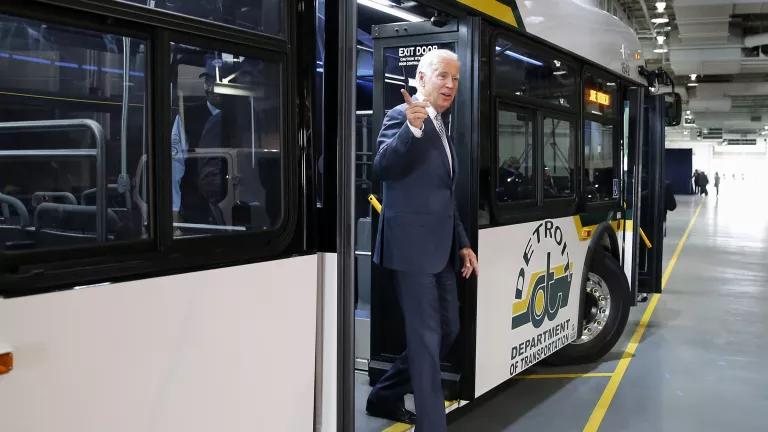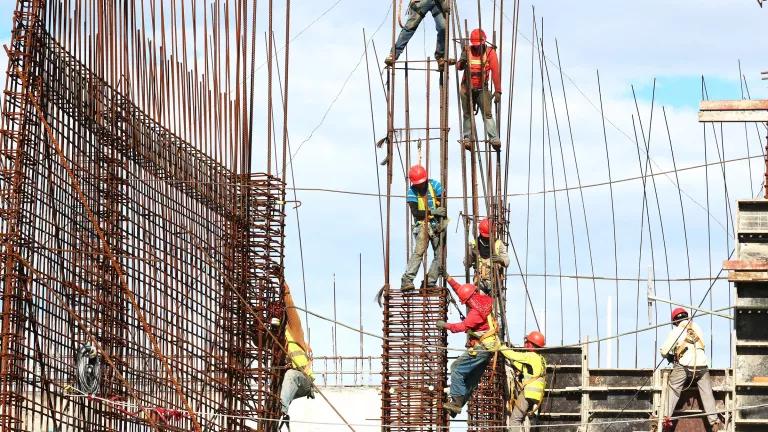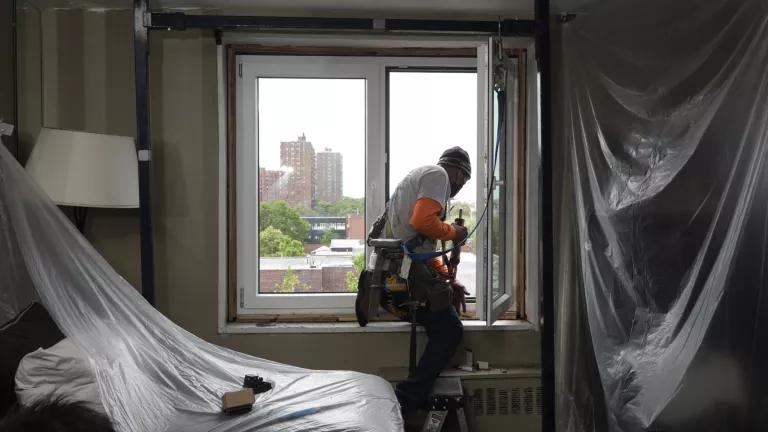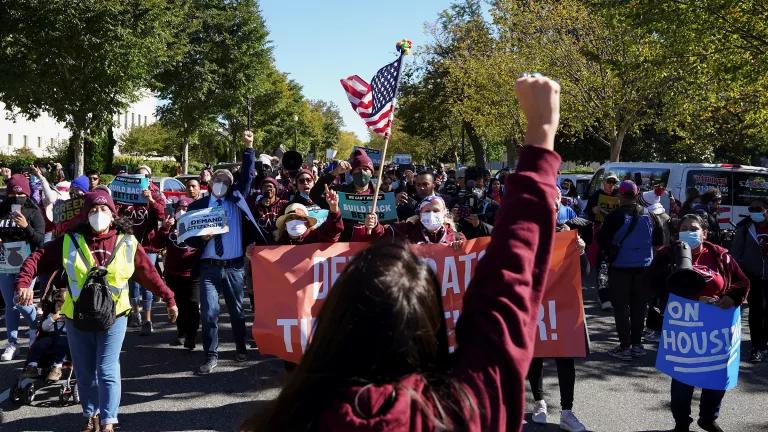Biden Promises Climate-forward, Equitable Transportation
The Biden-Harris administration has a plan for transportation to meet our climate goals by accelerating the deployment of electric vehicles, investing in 500,000 charging outlets by 2030, and providing every American city with 100,000 or more residents with high-quality, zero-emissions public transportation options.

Then-Vice President Joe Biden exits after touring a new bus in Detroit in September 2015.
Paul Sancya/Associated Press
The incoming Biden-Harris administration has promised to prioritize tackling four concurrent, intertwined crises: the COVID-19 pandemic, an historic economic downturn, decades of racial injustices, and more frequent and catastrophic events due to climate change. The Biden-Harris Build Back Better transition plan faces these crises head on.
Specifically, they plan to implement transformational policies and significant investments in our transportation system. At 28 percent of overall emissions in the United States, the transportation sector is the leading source of the United States' carbon emissions, and a major contributor to poor air quality and safety issues, especially in low-income communities and communities of color. Poor air quality contributes to over 100,000 deaths in the United States annually and traffic crashes have led to almost 50,000 pedestrian deaths over the last decade. The incoming administration knows that swiftly reducing emissions from transportation is critical to addressing the climate crisis and can improve the lives of Americans coping with the pandemic, high transportation costs, and poor air quality.
The Biden-Harris administration plan commits the United States to achieving a 100 percent clean energy economy, with net zero emissions, no later than 2050. To put transportation on this path, President-Elect Biden calls for accelerating the deployment of electric vehicles, investing in 500,000 charging outlets by 2030, and providing every American city with 100,000 or more residents with high-quality, zero-emissions public transportation options. Some of the most urgent actions for the Biden Administration should take include:
- securing the future of transit through at least $32 billion for emergency operations in a COVID relief bill,
- taking immediate executive actions including tightening vehicle greenhouse gas and other pollutant emission standards to achieve 100% zero emission sales by 2035 for cars and 2040 for trucks, and reinstating a Federal Highway Administration greenhouse gas performance measure for state and metropolitan plans, and
- working with Congress to pass a transformational Surface Reauthorization bill or infrastructure package at least as ambitious as the INVEST Act passed by the House of Representatives earlier this year.
The new Administration can accelerate a COVID recovery, boost the economy, remedy racial injustice and tackle climate change by incorporating the following foundational policies immediately and consistently throughout the next four years:
Investing in transit, $32 billion stimulus and at least $150 billion long term
Public transit is the backbone of a low-carbon, resilient transportation system. It reduces carbon emissions per trip and increases overall transportation affordability especially for communities of color and households that can’t afford one or more vehicles. During the pandemic, public transit has been a lifeline for almost three million essential workers who rely on it. While the CARES Act provided needed emergency funding for transit operators, that funding is starting to run out, especially in major metropolitan areas.
The Biden-Harris administration will need to continue to support critical transit operations as we recover from the pandemic through at least $32 billion in emergency stimulus funding followed by at least $150 billion in long-term investments through the Surface Reauthorization bill. Furthermore, overall funding for transit should be on par with highways and needs to include support for transitioning transit fleets to electric vehicles.
Cleaning up and electrifying vehicles through strong greenhouse gas emission standards
Vehicles will be a mainstay for travel by most households as well as for freight deliveries, and eliminating their emissions is critical. One of the first priorities of a Biden Administration should be reversing the Trump rollback of clean car and fuel economy standards, reinstating state authority to set protective standards and enacting new car and heavy truck standards that put the U.S. on the path to all new sales being zero emission by 2035 for cars and by 2040 for heavy trucks. The push for electric vehicles goes hand-in-hand with the Biden-Harris plan for a carbon pollution-free power sector by 2035.
To further accelerate the transition to electric vehicles, strong vehicle standards should be coupled with vehicle purchase incentives such as rebates and tax credits, EV charging infrastructure grants to achieve at least 500,000 charging outlets by 2030, and incentives for domestic zero emission vehicle and parts manufacturing to build jobs.
"I don’t want to bring the standards back, I’ll set new ambitious ones that our workers are ready to meet. I’ll also see American workers building and installing 500,000 electric vehicle charging stations along our newly engaged infrastructure programs and highways, all across the country."
—Joe Biden
Installing EV charging infrastructure
One of the biggest hurdles consumers face in switching to a pluggable car is a lack of consistent charging infrastructure. The Biden-Harris administration should work with Congress to pass the widely-supported Moving Forward Act (H.R. 2), which includes the INVEST in America Act, to fund at least $350 million per year in zero emission vehicle charging infrastructure across the country, complementing similar state programs. The new administration should also urge Congress to enhance charging deployment tax credits. Taken together, federal support should ensure that charging stations are accessible to all communities and enable the rapid electrification of cars and heavy trucks, especially around ports and other freight centers.
Reinstating a federal GHG performance metric for state transportation plans
The Trump administration eliminated an Obama era rule that required measurement of greenhouse gas emissions from state transportation plans. Specifically, this rule required all states to measure and set targets to reduce greenhouse gas emissions from the national highway system, which would translate to investments in low-carbon transportation infrastructure like transit, EVs, and active transportation networks.
As transportation has become the most polluting sector of our economy, reinstating this rule, and including it in the next Surface Reauthorization bill, will ensure states are required to measure, cap and reduce emissions going forward, therefore, aligning our infrastructure investments with the nation’s climate action and pollution reduction goals.
Investing in resilient, bikeable, walkable communities
Biking, walking, and scooting, also known as active transportation, is a key component to car-free and car-light living and investing in these options creates more jobs per dollar than any other infrastructure. When funded and implemented with high quality transit, these networks enable people to safely and conveniently access important destinations such as jobs, schools, transit centers, shops, health care, and parks and trails.
Specific means to deliver more active transportation options include increasing the Transportation Alternatives Program to $1.7 billion over five years through the next surface transportation reauthorization, amending the program to remove transferability to other highway programs except other climate-friendly programs like the Congestion Mitigation and Air Quality Program (CMAQ), and increasing the federal share for projects to 90 percent during COVID recovery. The Biden administration should also make active transportation a priority of discretionary grants to make up for decades of disinvestment and increase affordable mobility and well-being in communities of color.
Conclusion
The Biden administration knows investing in America’s transportation system can benefit the health and prosperity of every family and business, and investments must be focused on the communities who need them most—often Black, indigenous and low-income people disproportionately impacted by pollution and lack of transportation options.
Setting standards to eliminate pollution from our vehicles and investing in increasing equitable mobility for all is well within our reach and a critical part of meeting our carbon and pollution reduction goals.



